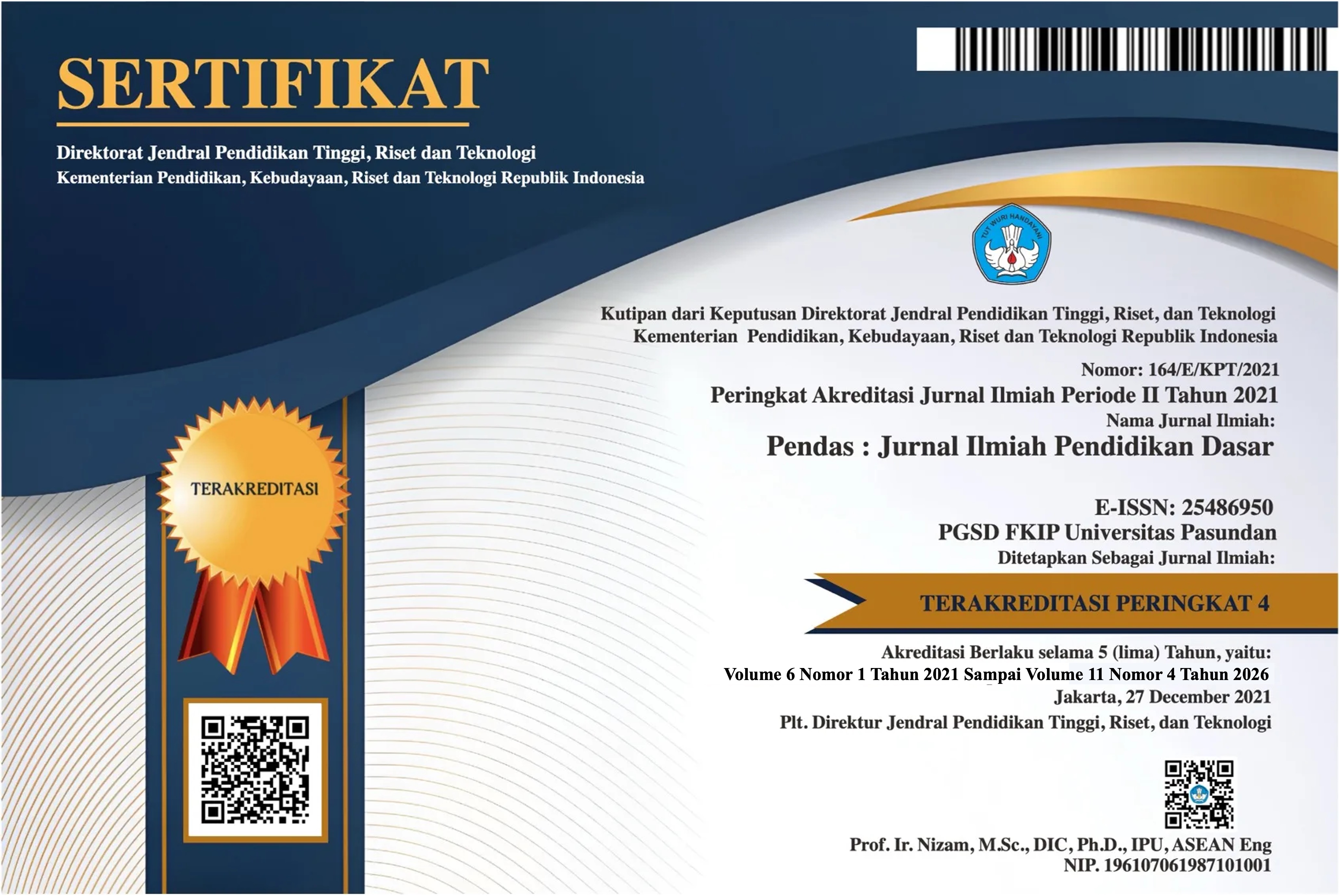PENGARUH PENGGUNAAN MODEL CTL BERBASIS BUDAYA SASAK TERHADAP LITERASI MATEMATIKA SISWA KELAS III SDN 20 CAKRANEGARA TAHUN AJARAN 2024
DOI:
https://doi.org/10.23969/jp.v9i2.16463Keywords:
CTL learning model, Sasak culture, mathematical literacyAbstract
This research aims to encourage the influence of the Sasak culture-based Contextual Teaching and Learning (CTL) learning model on the mathematical literacy abilities of class III students at SDN 20 Cakranegara. This research uses a quantitative approach with a quasi-experimental non-equivalent control group design. The population consisted of 56 students who were divided into two classes: class III A as the experimental class and class III B as the control class. The sampling technique used was a saturated sample, where the entire population was taken as the research sample. Data was collected through observation and written tests. The research instruments include written tests and observations, which have been tested for validity and reliability. The research results show that the application of the CTL model based on Sasak culture is effective in increasing students’ mathematical literacy. This is shown by the increase in the average posttest score in the experimental class (89.94) compared to the control class (78.57), as well as the results of the N-Gain test which shows a significant increase of 83% in the experimental class. Apart from that, the independent t-test results show a sig value. 2-tailed is 0.000, which is less than 0.05 (sig. 2-tailed < 0.05), so Ha is accepted and Ho is rejected. This shows that there is a significant influence of the Sasak culture-based CTL learning model on the mathematical literacy abilities of class III students at SDN 20 Cakranegara.Downloads
References
Abdussakir. (2018). Literatis Matematis dan Upaya Pengembangan dalam Pembelajaran di Kelas. Sumenep. Seminar Pendidikan Matematika STKIP PGRI Sumenep.
Fauzi, A.,Rahmatih, A. N., Sobri, M., Radiusman, & Widodo, A. (2020). Etnomatematika: Eksplorasi Budaya Sasak Sebagai Sumber Belajar Matematika Sekolah Dasar.5 (1), 1-13.
Hidayati, N., & Abdullah, A. A. (2022). Penerapan Model Pembelajaran Contextual Teaching and Learning ( CTL ) Berbasis Etnomatematika terhadap Kemampuan Pemecahan Masalah Matematika Siswa Kelas VIII SMPN 1 Bambanglipuro, 215–224.
Nur, A. S., & Palobo, M. (2017). Pengaruh penerapan pendekatan kontekstual berbasis budaya lokal terhadap kemampuan pemecahan masalah matematika. Jurnal Aksioma, 6(1), 1-13.
OECD, PISA. 2017. How Does PISA for Development measure mathematical literacy.Paris: OECD Publisher.
OECD. (2023). Hasil PISA 2022 (Volume I): Keadaan Pembelajaran dan Pemerataan Pendidikan. https://www.oecd-ilibrary.org/sites/53f23881-en/index.html?itemId=/content/publication/53f23881-en
Ota, M. K. (2019). Pembelajaran Matematia Berbasis Budaya Daerah Ngada Untuk Melatihkan Keterampialn Berpikir Kritis Siswa Kelas III Sekolah Dasar Inpres Turekisa. Wahana Matematika dan Sains: Jurnal Matematika, Sains, dan Pembelajarannya, 13(2), 14-26.
Pranata, N., Nindiasari, H., & Fatah, A. (2020). Efektivitas Pendekatan Kontekstual Terhadap Kemampuan Literasi Matematis Siswa SMP Berbasis Karakter dan Budaya Lokal. Wilangan: Jurnal Inovasi dan Riset Pendidikan Matematika, 1(3), 236-244.
Priadana, S & Denok, S. (2021). Metode Penelitian Kuantitatif
Pusmendik, (2015). Studi Internasional TIMSS Pusat Asesmen Pendidikan. https://pusmendik.kemdikbud.go.id/produk/kategori-asesmen-terstandar/page-studi-internasional-timss
Raharjo, Sahidsah. (n.d.). Cara Uji Independent Sample T-Test dan Interpretasi dengan SPSS. Spss Indonesia Oleh Data Statistika Dengan Spss. Retrieved November 30, 2023, from https://www.spssindonesia.com/2015/05/cara-uji-independent-sample-t-test-dan.html
Stecey, K & Tuner, R., 2015. Assessing Mathematical Literacy: The PISA experience, Australia: Springer.
Sugiyono, (2019). Metode Penelitian Kuantitatif dan Kualitatif, dan R & D. Bandung: ALFABETA
Supiyati, S., Hanum, F., & Jailani. (2019), Ethnomathematics in sasaknese architecture. Journal on Mathematics Education, 10(1), 47-57. https://doi.org/10.22342/jme.10.1.5383.47-58
Turmuzi, M., Sudiarta, I. G. P., & Suharta, I. G. P. (2022). Systematic literature review: Etnomatematika kearifan lokal budaya Sasak. Jurnal Cendekia: Jurnal Pendidikan Matematika, 6(1), 397-413.
Downloads
Published
Issue
Section
License
Copyright (c) 2024 Pendas : Jurnal Ilmiah Pendidikan Dasar

This work is licensed under a Creative Commons Attribution 4.0 International License.



















